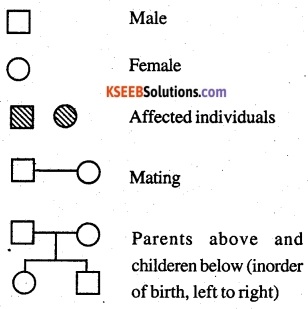You can Download Chapter 5 Principles of Inheritance and Variation Questions and Answers, 2nd PUC Biology Question Bank with Answers, Karnataka State Board Solutions help you to revise complete Syllabus and score more marks in your examinations.
Karnataka 2nd PUC Biology Question Bank Chapter 5 Principles of Inheritance and Variation
2nd PUC Biology Principles of Inheritance and Variation NCERT Text Book Questions and Answers
Question 1.
Mention the advantages of selecting pea plant for experiment by Mendel.
Answer:
Mendel selected pea plant because:-
- It possesses a large number of varieties.
- Pure varieties of this plant were available.
- Plant is small and flower is large enough to hand manually.
- Flowers are bisexual and produces fertile hybrids.
- Each plant produces a large number of seeds.
- Plants are self pollinated and can be cross pollinated.
- Plant is annual with growth period of few months.
- Chances of contamination are very less.
Question 2.
Differentiate between:-
(a) Dominance and Recessive.
Answer:
| Dominance | Recessive |
| 1. Able to express even in presence of contrasting allele. 2. Does not require another similar allele to produce its phenotype. 3. Produces complete polypeptide, protein or enzyme. 4. It is usually wild type allele. |
1. Cannot express in presence of contrasting allele. 2. Can produce its phenotype only along with similar allele. 3. Forms incomplete products. 4. Usually a mutant allele. |
(b) Homozygous and Heterozygous.
Answer:
| Homozygous | Heterozygous |
| 1. Possesses similar alleles. 2. 2 types – Homozygous dominant and recessive. 3. Individual is pure for the trait. 4. On self breeding, similar type of offspring are formed. 5. Only one type of gamete is formed |
1. Possesses different alleles. 2. Is of one type 3. Individual is seldom pure for trait. 4. On breeding, 3 types of offspring are formed. 5. 2 types of gametes produced. |
(c) Monohybrid and Dihybrid
Answer:
| Monohybrid | Dihybrid |
| 1. Cross made between individual having contrasting traits in order to study the inheritance of a pair of alleles. 2. Phenotypic monohy brid ratio in F2 generation is 3:1. 3. Genotypic monohybrid ratio in F2 generation is 2:1. |
1. Cross made between individuals having contrasting traits inorder to study the inheritance of 2 pair of alleles. 2. Phenotypic dihybrid ratio is 9:3:3:1 3. Genotypic dihybrid ratio is 1:2:1:2:4:2:1:2:1 |
Question 3.
A diploid organism is heterozygous for 4 loci, how many types of gametes can be produced?
Answer:
Number of gametes = 2n
n = Number of loci, n = 4
So, 24 = 2×2×2×2 = 16 types of gametes.
Question 4.
Explain the law of Dominance using a monohybrid cross.
Answer:
Law of Dominance:
- Characters are controlled by discrete units called factors.
- Factors occurs in pairs.
- In a dissimilar pair of factors one member of the pair dominates (dominant) the other (recessive) supresses.
In a monohybrid cross:-

![]()
Question 5.
Define and design a test cross.
Answer:
Test cross: An organism showing dominant phenotype (genotype is to be determined.) from F2 is crossed with recessive parent instead of self-crossing. Progenies of such a cross can be analysed to predict genotype of test organism. Eg: Tall and short plant taken into experiment. From F2 generation, TT or Tt could be tall I plant. Recessive parent will be tt. So,

So, if test plant was TT, resulting plant will only I tall. If test plant was Tt, resulting plant will be tall and short.
Question 6.
Using a punnett square, workout distribution of phenotypic features in the F1 generation after cross between homozygous female and heterozygous male for single locus.
Answer:
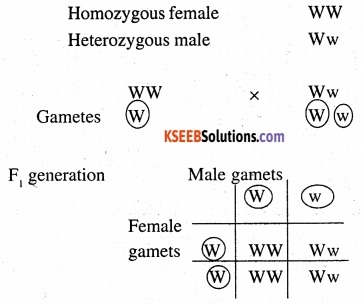
Question 7.
When cross is made between hybrid tall plant with yellow seeds (Tt Yy) and tall plant with green seeds (Tt yy), What proportion phenotype in offspring could be expected to be
(a) Tall and Green
(b) Dwarf and Green
Answer:
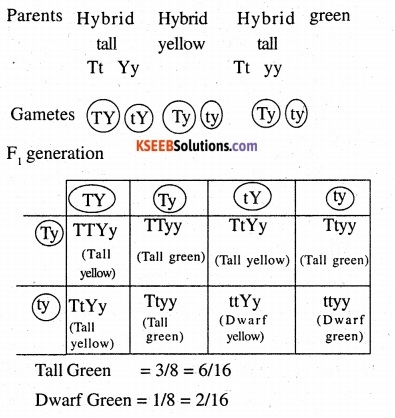
Question 8.
Two heterozygous plants are crossed. If 2 loci are linked what would the distribution of phenotypic features in F1 generation in dihybrid cross.
Answer:
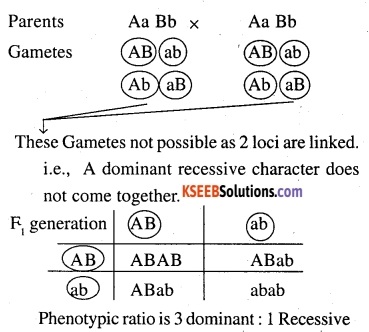
Question 9.
Mention the contributions of TH Morgan in Genetics.
Answer:
TH Morgan is a Genetist who got Nobel Prize.
- He found fruit fly (Drosophila Melanogaster) to be a experimental material as it was easy to rear and multiply it.
- Established presence of genes over the chromosomes.
- Principle of linkage and crossing over.
- Discovered sex linkage and crossing over.
- He observed mutations.
- Developed technique of chromosome mapping,
- Wrote book “The theory of Gene”.
![]()
Question 10.
What is pedigree analysis ? Suggest how such analysis can be useful.
Answer:
Pedigree analysis: Study of transmission of particular traits graphically over the present and the last few generation for finding out possibility of their occurrence in future generations. So, analysis of traits in a several generations of a family is called Pedigree Analysis.
Importance:
- To know possibility of a recessive allele which may create disorder.
- Can indicate origin of a trait in the ancestors.
- Analysis is used for genetic counselling.
- Extensively used in medical research.
Question 11.
A child has blood group O. If the father has blood group A and mother B, work out genotypes of parent and the possible genotypes of other offsprings.
Answer:
Blood group O can appear with 1° 1° only (2 recessive allele).

Question 12.
How is sex determined in human beings?
Answer:
In humans there are 23 pairs of chromosomes. 22 pairs of these chromosomes do not take part in sex determination called autosomes. The 23rd pair determines the sex of individual called allosome or sex chromosome. If it is XX then female, if XY then male. Presence of Y1 makes a person male. Human females produce only 1 type of gamete 22 + X. In male it could be 22 + X or 22+ Y.
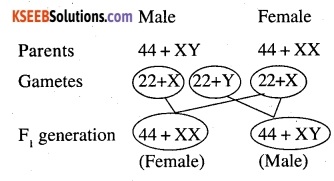
Question 13.
Explain the following terms with example
(a) Co-dominance
(b) Incomplete dominance
Answer:
(a) Co-dominance: Phenomenon of 2 different alleles of same gene lacking dominance – recessive relationship and expressing their effect simultaneously in heterozygote.
Eg: 1A and 1B alleles in AB blood group of humans.
(b) Incomplete dominance: Phenomenon of neither of 2 alleles of a gene being dominant over each other so that when both of them are present together, a new phenotype is formed which is somewhat intermediate between both of their independent expression. Eg: Flower colour is Snapdragon and 4’0 clock plant.
![]()
Question 14.
What is point mutation ? Give example.
Answer:
Point mutation: Gene mutation that occurs due to change in single base pair of DNA. It results in incorporation of different DNA. Eg: Valine instead of glutamic acid in [3 -peptide in sickle cell anaemia.]
Question 15.
Who had proposed chromosomal theory of inheritance ?
Answer:
Sutton and Boveri (1902)
Question 16.
Mention 2 autosomal genetic disorder with their symptoms.
Ans:
(a) Sickle Cell Anaemia :- Autosomal Recessive (chr. 11)
Symptoms:- Anaemia due to RBC destruction.
(b) Phenylketonuria :- Autosomal Recessive (Chr.12)
Symptoms:- Brain fails to develop in infancy, mental retardation.
(c) Cystic Fibrosis :- Autosomal Recessive (Chr.7)
Symptoms:- Mucus clogging in lungs, liver and pancreas.
2nd PUC Biology Principles of Inheritance and Variation Additional Questions and Answers
2nd PUC Biology Principles of Inheritance and Variation One Mark Questions
Question 1.
Give the meaning of the term allele.
Answer:
It represents a pair of genes of 2 alter-natives of the same character and occupies the same position (locus) on the homologous chromosome. OR The various forms of genes are called alleles.
Question 2.
What is pleiotrophy? Give one example.
Answer:
A phenomenon where one gene controls more than one phenotypic characters of an organism. Eg: In Pisum sativum, a gene that regulates colour of flowers also regulates the colour of seed coat.
Question 3.
What is Genetics?
Answer:
The branch of biology that deals with the inheritance and variation of characters from parents to offspring.
Question 4.
What is variation in genetics?
Answer:
The degree by which the progeny differs from the parents in a character.
Question 5.
What term did Mendel use for what we now call the genes? [Hots]
Answer:
Factors or determination.
![]()
Question 6.
What is a true breeding line?
Answer:
It is one that has undergone continuous self pollination and shows the stable trait inheritance and expression of it for several generation.
Question 7.
Define Phenotype.
Answer:
The observable or external characteristic of an organism, constitute its phenotype.
Question 8.
Define genotype.
Answer:
The genetic constitution of an organism is called genotype.
Question 9.
What is monohybrid cross?
Answer:
The cross made between individuals of a species, considering the inheritance of the contrasting pair of a single character.
Question 10.
What is dihybrid cross?
Answer:
The cross made between individual of a species considering the inheritance of the contrasting pairs of 2 characters.
Question 11.
Name the plant in which Mendel performed his experiment.
Answer:
Pea plant – Pisum sativum.
Question 12.
What is the importance of pedigree analysis?
Answer:
It reveals the ancestral history of an individual and its possible genotype for a trait.
Question 13.
Mendel observed 2 kinds of ratios, i.e., 3:1 and 1:2:1 in F2 generation in his experiments on garden pea. Name these two kinds of ratios respectively.
Answer:
- 3:1 – Phenotypic ratio
- 1:2:1 – Genotypic ratio.
Question 14.
What are.codominant alleles ? Give one Example.
Answer:
The genes of an allele morphes pair are not related as dominant or recessive but both are equally potent to express themselves in F1 hybrid. Eg: Blood group AB where alleles
IA and IB are codominant.
Question 15.
What is epistasis?
Answer:
It is the interaction between two different genes (non-allelic genes) where one gene masks the effect of another gene.
Question 16.
When a tall pea plant was self pollinated, one fourth of the progeny were dwarf. Give the genotype of all the parent + the dwarf progenies.
Answer:
- Parent: Tt Dwarf
- progenies : tt
![]()
Question 17.
‘Give the scientific name and the common name of plant in which incomplete dominance was first discovered.
Answer:
Four O’clock plant – Mirabilis jalapa.
Question 18.
Define the term heterozygous.
Answer:
It is an individual who possesses two different alleles of a character on its homologous chromosome.
Question 19.
What is the phenotypic and genotypic ratio of incomplete dominance?
Answer:
The phenotypic and genotypic ratios are same i.e. 1AA : 2Aa : laa
Question 20.
Define the law of independent assortment of genes.
Answer:
The two genes of each character assort independently of the genes of other characters at the time of gamete formation and gets randomly rearranged in the offspring.
Question 21.
What are the glycoprotein found on the RBC’s of a person with blood group AB?
Answer:
Glycoprotein A and B are found.
Question 22.
Why is no glycoprotein found on the RBC’s of a person with ‘O’ blood groups?
Answer:
Glycoprotein found on the RBCs are coded by the dominant alleles, (IA and IB); since the person with the blood group “O” is homozygous recessive, no glycoprotein is found on RBCs.
Question 23.
What are complementary genes ?
Answer:
These are the two independent pairs of genes which interact to produce a trait together
but each dominant genes alone does not show its effect.
Question 24.
What is gene pool?
Answer:
It is the genotypes of all the individuals in a population.
Question 25.
Name the pigments that controls skin colouration in man. [Hots]
Answer:
Melanin.
Question 26.
Who first observed ‘X’ chromosome ?
Answer:
Henking. [Hots]
Question 27.
Why ‘X’ chromosome is called as sex chromosome ?
Answer:
It involves in the sex determination of an individual.
Question 28.
Why is Drosophila (male) referred to as heterogametic ?
Answer:
A male drosophila produce 2 types of gametes i.e., X and Y. Therefore they are heterogametic.
Question 29.
Define heterogamety. Give an example.
Answer:
It is a phenomenon in which organisms produce 2 types of (more than one type) gametes. Eg: Human male, male drosophilla / female fowl.
Question 30.
Define mutation.
Answer:
It is defined as sudden heritable change in the base sequence of DNA or structure of chromosome or a change in the number of chromosomes, that changes the phenotype of an organism.
Question 31.
Give the term for the factors which causes mutation.
Answer:
Mutagenes.
Question 32.
Mention 2 sex-linked Mendelian disorders.
Answer:
Haemophilia and colour blindness
Question 33.
Name some diseases which can be avoided in the progeny through pedigree analysis of parents.
Answer:
Colour blindness, Tuberculosis, Turner’s syndrome.
Question 34.
Give the reason for Down’s syndrome.
Answer:
Trisomy of 21st chromosome.
Question 35.
Define trisomic condition.
Answer:
When a particular chromosome is present in 3 copies in a diploid cell, the condition is called trisomic condition.
36.
Define monosomic condition.
Answer:
When a particular chromosome is present in a single copy in a diploid cell, the condition is called monosomic condition.
2nd PUC Biology Principles of Inheritance and Variation Two Marks Questions
Question 1.
Define test cross. What is its significance?
Answer:
It is the cross between an individual with dominant phenotype with an individual homozygous recessive for the trait. It is used to determine the genotype of an individual for any character trait.
Question 2.
What are multiple alleles ? Give an example.
Answer:
When a gene exist in more than 2 allelic form, the alleles are called multiple alleles.
Eg: The gene ‘I’ controls the human blood group. It exist in 3 different alleleic form i.e., IA IB and i.
Question 3.
Write T.H.Morgan’s contribution for genetics.
Answer:
- Morgan conducted experiments in Drosophilla melanogaster and discovered.sex linkage.
- He also found that linked genes may show the phenomenon called linkage where the recombinants in a test than 50%. cross progeny are less
![]()
Question 4.
Differentiate between monohybrid and dihybrid.
Answer:
| Monohybrid | Dihybrid |
| It is a cross, where 2 forms of single trait are hybridised. | It is a cross where 2 forms of 2 different traits are hybridised. |
Question 5.
Differentiate between genotypes and phenotype.
Answer:
| Genotype | Phenotype |
| (a) It is the total genetic constitution of an individual. | (a) It is the external appearnce of an individual. |
| (b) It is the expression of genome or more specifically the alleles present at one locus. | (b) It is the expression of genotype produced under the influence of an environment. |
Question 6.
Differentiate between test cross and reciprocal cross.
Answer:
| Test cross | Reciprocal cross |
| It is a cross between, F1 hybrid and recessive parent. It confirms the purity of F1 hybrid whether it is homozygous or heterozygous. | It is the second cross involving the same strains carried by sexes opposite to those in the first cross. It is able to distinguish between nuclear chromosomal and sex linked inheritance. |
Question 7.
Is not possible study the inheritance of traits in humans in the same way as in peas. Give 2 main reason for it and the alternative method used for such study.[Hots]
Answer:
Mendel’s laws are not applicable for human beings because:
- In human the generation time is too long and produces a small progeny. It creates difficulty in statistical computation of any generation of individuals.
- Human cannot be crossed at will. Pedigree analysis is the another method used to study the family instances and the transmission of particular trait generation after generation.
Question 8.
What is back cross?
Answer:
When an intercross done between 2 genetically different parents, a hybrid is produced which may be homozygous or heterozygous. To determine the purity of parents and to test genotypes of F1 hybrid, a cross is made between F1, hybrid and of the parent. Such cross is known as backcross.
Question 9.
How would you find the genotype of an organism exhibiting a dominant phenotypic trait?[Delhi 2008]
Answer:
First a test cross will be done between the dominant phenotypic individual (F1 hybrid) with recessive phenotypic individual (parent). If the individuals are homozygous dominant, all the individuals in the progeny
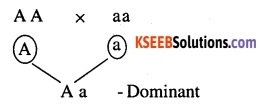
If the individuals are heterozygous, the progeny will show dominant phenotype and recessive phenotype in the ratio 1:1.
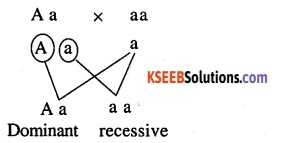
Question 10.
What is pedigree analysis ? How such an analysis can be useful ?
Answer:
In human genetics controlled crosses are not possible. Pedigree analysis provide a strong tool to study the family history inheritance of a particular trait.It is uitlised to trace the inheritance of any particular abnormality or disease.
Question 11.
What is meant by chromosomal abberation? In which type ofvcells it commonly occurs?
Answer:
Alternation in chromosome is due to the deletion / duplication / addition of a segment of DNA is called chromosomal abberation. Commonly occurs in cancerous cells.
Question 12.
What is point mutation ? Give an example.
Answer:
The mutation that arises due to change in a single base pair of DNA, is known as point mutation. Eg: sickle cell anaemia.
Question 13.
Classify the following into chromosomal and Mendelian disorder.
(a) Cystic fibrosis
(b) Turner’s syndrome
(c) Klinefelter’s syndrome
(d) Haemophilin
Answer:
(a) Cystic fibrosis – Mendelian disorder
(b) Turner’s syndrome – Chromosomal disorder
(c) Klinefelter’s syndrome – Chromosomal disorder
(d) Haemophilia – Mendelian disorder
Question 14.
Give the chromosomal constitution and the resulting sex in each of the following syndrome.
(a) Turner’s syndrome
(b) Klinefelter’s syndrome
Answer:
Turner’s syndrome – 22 pairs of autosomes and one X chromosome.
(44 + XO = 45 chromosome)
The resulting individual is female. Klinefelter’s syndrome – 22 pairs of autosomes and XXY = [44 + XX Y = 47 chromosomes].
The resulting individual is male with more female character.
![]()
Question 15.
What is haemophilia due to? What happens in this disorder?
Answer:
Haemophilia is due to a defective recessive allele located on the ‘X’ chromosome. In this disorder, a single protein which is involved in clotting of blood is affected. As a result, the individual bleeds even from a simple cut, that may become fatal.
Question 16.
The human male never passes on the gene for haemophilia to his son. Why?
OR
Why do sons of haemophilia father never suffer from this trait?
Answer:
The genes for haemophilia is present on the ‘X’ chromosome only. A male has only one ‘X’ chromosome. Which he receives from his mother. He receives ‘Y’ chromosome from father. The human male passes the ‘X’ chromosomes to his daughters not to the male progeny.
Question 17.
Differentiate between haemophilia and sickle cell anaemia.
Answer:
| Haemophilia | Sickle cell anaemia |
| 1. It is due to recessive defective allele present on X – chromosome. 2. It is a sex linked ‘disorder. 3. A protein necessary for clotting of blood is deficient. |
1. It is due to point mutation i.e., a single base pair change leading to a change in an aminoaied. 2. It is a autosomal disoder. 3. The defective haemoglobin leads to a change in the shape of RBCs, which become sickle celled. |
Question 18.
Differentiate between Turners and Klinefelter’s syndrome.
Answer:
| Turner’s Syndrome, | Klinefilter’s Syndrome |
| 1. The individual is female. | 1. The individual is male. |
| 2. The individual has one X chromosome less i.e., she has 45 chromosomes. | 2. The individual has an extra X chromosome i.e., 47 chromosome. |
| 3.The individual has a short stature with an under developed feminine character. | 3. The individual has a tall stature with a feminised character. |
Question 19.
Describe Mendel’s observation on the hybridization experiments on garden pea.
Answer:
- The F hybrids always showed one of parental forms of the trait and there was no blending of traits.
- Both the parental form of traits appeared without any change / blending in the F2 generation.
- The form of the trait appeared in the F1 generation is called dominant character and it appeared in the F2 generation about 3 times in frequency as that of its alternate form.
Question 20.
Why Mendel selected pea plants for his experiments?
Answer:
Mendel selected pea plants on the basis of following characters:
- Pea plant exhibited number of contrasting characters.
- It normally undergoes self pollination but can be cross pollinated manually.
- It is an annual plant and yield’s result in a year’s time, so it can be observed for many generation.
- Many varieties were available with observable alternative forms for a trait.
- Pure varieties of pea were available which always bred true.
- Large number of seeds are produced per plant which can be easily handled and cultivated.
![]()
Question 21.
List any 7 traits in garden pea which Mendel studied in his breeding
Answer:

Question 22.
What are the reasons for success of Mendel’s experiment on pea plant.
Answer:
- Mendel studied one or two characters at a time for his breeding experiment
- He selected only those traits for his experiments which did not exhibit linkage or incomplete dominance.
- He performed the reciprocal crosses to confirm the validity of the correct ratio.
- He performed his experiment to F2 + F3 generation.
- He selected true breeding varieties of pea plant for cross pollination.
- He performed emasculation process to prevent self pollination.
- He maintained complete records of all his ‘ experiments and used statistical method and law of probability for analysing his results.
- He took great care in finding and choosing the true breeding plants genetically.
Question 23.
A pea plant with Purple flowers was crossed with a plant with white flowers producing 40 plants with only purple flowers. On selfing these plants produced 470 plants with purple flower 162 with white flowers. What genetic mechanism account for this results ?
Answer:
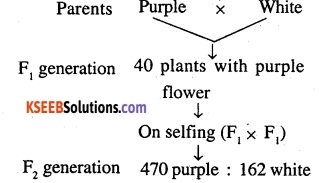
F2 generation 470 purple : 162 white. In F1 generation only purple flowers producing plants appeared. This means purple colour is dominant. Which doesn’t allow the white colour to express itself.
In F2 generation, purple and white coloured flowers were produced in the ratio 3:1. Here the parental character of white again reappeared in about one fourth of the progeny. This occurs due to segregation of genes in the gamete formation. This represents the law of segregation and monohybrid ratio.
Question 24.
In human beings, blue eye colour is recessive to brown eye colour. A brown eyed man has a blue eyed mother
(a) What is the genotype of the man and his mother?
(b) What are the possible genotype of his father?
(c) If a man marries a blue eyed woman, what are the possible genotypes of their offsprings ?
Answer:
As per the given condition, the brown eye colour is dominant over the blue eye colour.

(a) The mother’s genetype must be ‘bb’ as she is recessive for blue coloured eye.-The man is brown-eyed (dominant). Its possible genotype must be ‘Bb’ as he is procuring one of the recessive gene from his mother.
(b) As the genotype of the man is ‘Bb’ so the possible genotypes of his father may be BB or Bb
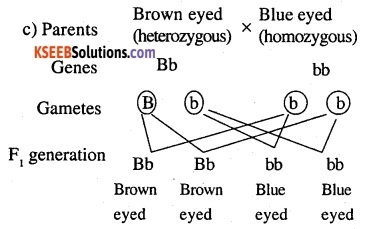
Question 25.
How do you relate dominance, co-dominance and incomplete dominance in the inheritance of character.
Answer:
- Dominance: It is the phenomenon in which one of the alleles of a gene expresses itself in the hybrid / heterozygous condition. While the other is suppressed (recessive) in the presence of the other.
- Codominarice: It is the phenomenon in which 2 alleles of a gene are equally dominant and express themselves in the presence of the other
- Incomplete dominance: It is the phenomenon in which neither of two alleles of a gene is completely dominant over the other and the hybrid is intermediate between the two parents.
Question 26.
Describe the XO- type of sex determination. [HOTS]
Answer:
XO – type of sex determination occurs in certain insects like grasshoppers. The males have only one X – chromosome and hence they have one chromosome less than that females. All the ova contains autosomes and one X chromosome. 50% of the sperm contains one X chromosome besides the autosomes, while 50% of sperm don’t have X – chromosomes. Sex of the individual is determined by the type of sperm fertilizing ovum. Egg fertilized by sperm having an X- chromosome developed into female. Egg fertilized by sperm having no chromosome develop into male.
Question 27.
Describe the different types of mutation.
Answer:
- Mutation is a phenomenon arising from alteration of DNA sequences or structure or number of chromosomes.
- Loss (deletion) or gain (insertion / duplication) of a segment of DNA results in the alteration in chromosome structure, which is called as chromosomal aberration.
- When mutation arises due to a change in single base pair of DNA, it is known as point mutation. Eg: Sickle cell anaemia.Deletion or addition of base pairs of DNA causes frame shift mutation.
2nd PUC Biology Principles of Inheritance and Variation Five Marks Questions
Question 1.
What is incomplete dominance ? Describe with one example.
Answer:
When 2 parents are intercrossed with each other, the hybrid that produced doesn’t resemble either of the parents, but mid way between 2 parents. The phenomenon of incomplete dominance occurs in Four O’ clock plant (Mirabilis Jalopa) and Snapdragon (Antirrhinum Majus). A cross between red flowered (RR) and a white flowered (rr) plant yields the hybrid flowered (Rr) one which is of pink colour in F, generation.
The pink hybrids on crossing with each other give the usual Mendelian ratio 1 : 2 : 1 (one red : 2 pink : 1 white). In this the gene “R is not completely dominant over the allele ‘r’. The heterozygous Rr synthesises only half pigment, so they are pink in colour.
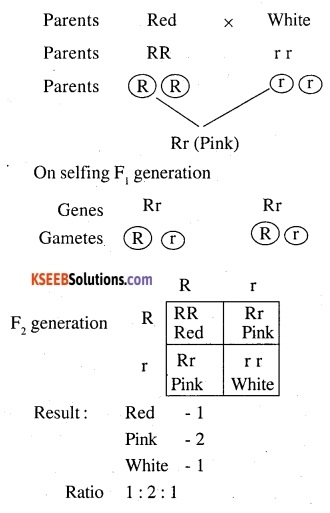
Question 2.
In Snapdragons, tall (DD) is dominant over dwarf (dd) and Red (RR) are incompletely dominant over white (rr), the hybrid being pink. A pure tall white is crossed to a pure dwarf red and F2 are self fertilized. Give the expected genotype and phenotype in F1 and F2 generations.
Answer:
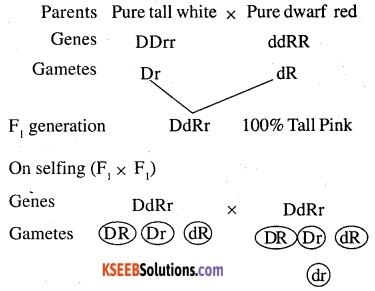
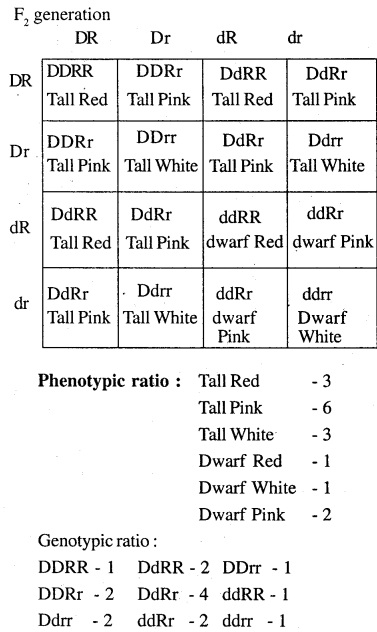
Question 3.
Describe sex determination in certain Birds.
Answer:
- In birds, sex determination is of ZW type, both males and females have same number of chromosomes.
- The males have autosomes plus a pair of Z- chromosomes.
- The females along with autosomes ZW chromosomes.
- The males are homogametic and produce sperms carrying one Z – chromosome along with autosomes.
- The females are heterogametic and produces 50% of ova carrying one Z – chromosome and the remaining 50% carrying one W – chromosomes.
- Sex of the individual is determined by the type of ovum fertilized.
- When an ovum containing Z chromosome is fertilized; the zygote (ZZ) develops into male.
- When an ovum containing W chromosome is fertilized; the zygote (ZW) develops into female.
![]()
Question 4.
Study the Pedigree analysis chart and answer the question given below: [CBSE 2008]
Answer:
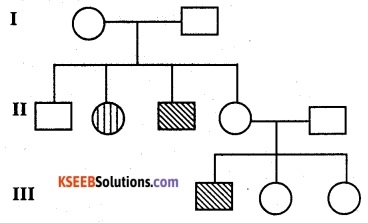
(a) Is the trait recessive or dominant?
(b) Is the trait sex-linked or autosomal?
(c) Give the genotypes of the parents in Generation I and of their 3rd and 4th child in Generation II.
Answer:
(a) The trait is recessive
(b) The trait is autosomal
(c) Parent Aa and Aa
3rd child is II generation – aa 4th child is II generation – Aa
Question 5.
Study the given pedigree chart show the inheritance pattern of a human trait and answer questions given below.
(a) Give the genotype of parent in 1st generation and of son and daughter shown in 2nd generation.
(b) give the genotype of daughters shown in 3rd generation.
(c) Is the trait sex linked or autosomal. Justify your answer.
Answer:
(a) Genotypes of parents in Generation 1. Male – Aa Female – Aa Son (Generation II) – Aa Daughter (Generation II) – aa.
(b) Genotype of the daughter in Generation III – Aa
(c) It is an autosomal trait and not sex-linked because if it is a sex-linked, the daughter in generation II cannot have it.
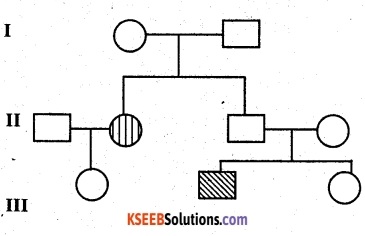
Question 6.
A girl baby has been reported to suffer from haemophilia. How is it possible ? Explain with the help of a cross.
Answer:
(a) Haemophilia is due to the presence of a recessive defective allele on X – chromosome.
(b) A female with XX – chromosome must be homozygous for the disease to appear.
(c) She must receive one of the alleles from her haemophilie father (XhY) and the other from her mother who is also an haemophilie or at least a carrier i.e. the heterozygous for the disease XXh.
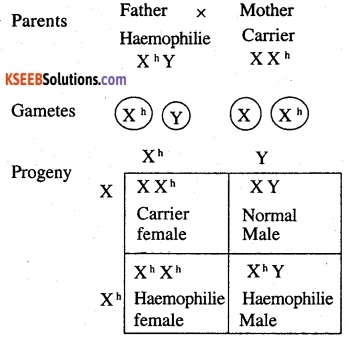
Question 7.
How are Pedigree charts prepared ?
Answer:
- Squares denotes males.
- Circles denotes females.
- Mating is shown by horizontal line connecting a male symbol with a female symbol.
- Off springs symbols are rearranged from left to right in the order of their birth and connected by a horizontal line below the parents and this line is connected to the parents marriage line by a vertical line.
- A solid or blackened symbol represent the individual with the trait under study.
- An open / clear symbol represents the absence of trait under study.
